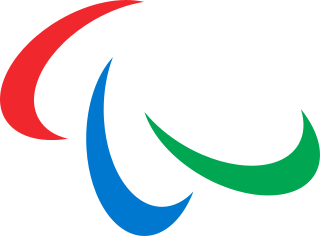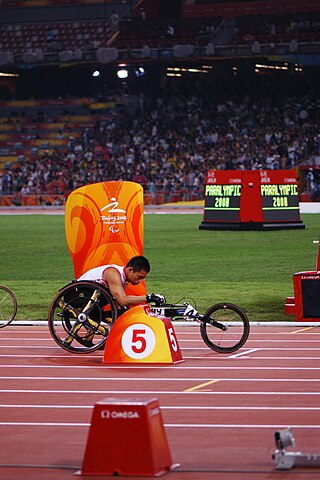
The Summer Paralympics, also known as the Games of the Paralympiad, are an international multi-sport event where athletes with physical disabilities compete. This includes athletes with mobility disabilities, amputations, blindness, and cerebral palsy. The Paralympic Games are held every four years, organized by the International Paralympic Committee. Medals are awarded in every event, with gold medals for first place, silver for second and bronze for third, a tradition that the Olympic Games started in 1904.
T38 and CP8 are disability sport classification for disability athletics intended for people with cerebral palsy. It includes people who have coordination impairments such as hypertonia, ataxia and athetosis. Runners in this class may appear to have a slight limp when they are running but otherwise have a stride similar to able-bodied runners. Events for this class include 100 meters, 400 meters, 1,500 meters, and the long jump.
F31 is a disability sport classification for seated throwing events in disability athletics. The only event this class competes in at the Paralympic Games is the club throw.
T32 is disability sport classification for track events in disability athletics. This is a wheelchair racing class. The classification is one of three classes of wheelchair racing for people with athetosis, ataxia or hypertonia. The number of events available to people in this class has decreased since the 1980s, with no T32 events at the 2016 Summer Paralympics. While undergoing classification, T32 competitors both undergo a bench test of muscle coordination and demonstrate their skills in athletics.
T33 and CP3 are disability sport classification for disability athletics. The class competes using a wheelchair. The classification is one of eight for people with cerebral palsy, and one of four for people with cerebral palsy who use a wheelchair. Athletes in this class have moderate quadriplegia, and difficulty with forward trunk movement. They also may have hypertonia, ataxia and athetosis.
T35 is a disability sport classification for disability athletics' running competitions. It includes people who have coordination impairments such as hypertonia, ataxia and athetosis. This includes people with cerebral palsy. The classification is used at the Paralympic Games. The corresponding F35 classification includes club and discus throw, shot put, and javelin.
T36 is a disability sport classification for disability athletics. It includes people who have coordination impairments such as hypertonia, ataxia and athetosis. It includes people with cerebral palsy. T36 is used by the International Paralympic Committee. This classification competes at the Paralympic Games.

T37 is a disability sport classification for disability athletics in track and jump events. It includes people who have coordination impairments such as hypertonia, ataxia and athetosis. It is the athletics equivalent of the more general CP7 classification.
T51 is disability sport classification for athletics. The class includes people with a number of different types of disabilities including spinal cord injuries and cerebral palsy. Similar classifications are T52, T53, T54 and T55. It is for sportspeople with minimal upper body function who use a wheelchair, spinal cord injury class F1 and Les Autres class LAF1.
T52 is disability sport classification for disability athletics. People in this class have good shoulder and upper body control, but lack fine motor skills in their arms and hands. They have no or limited trunk and leg function. The class includes people with a number of different types of disabilities including spinal cord injuries. Similar classifications are T51, T53 and T54.

T54 is a disability sport classification for disability athletics in the track and jump events. The class includes people with spinal cord injuries who compete using a wheelchair in track events. They have paraplegia, but have normal hand and arm function, normal or limited trunk function, and no leg function. This class includes CP-ISRA classes CP3 and CP4, and some athletes in ISOD classes A1, A2 and A3.

T53 is disability sport classification for disability athletics. The class includes people with a number of different types of disabilities including spinal cord injuries. People in this class have full use of their arms but have no or limited trunk function. Similar classifications are T51, T52, and T54. People in this class have a functional upper limbs, but limited trunk usage and limited lower limb functionality. During classification, they both undergo a bench test of muscle strength and demonstrate their skills in athletics. People in this class include Tanni Grey-Thompson (GBR), Samantha Kinghorn (GBR), Angie Ballard (AUS) and Richard Colman (AUS).
Para-athletics classification is a system to determine which athletes with disabilities may compete against each other in para-athletics events. Classification is intended to group together athletes with similar levels of physical ability to allow fair competition. Classification was created and is managed by the International Paralympic Committee (IPC), which is regularly published via its IPC Athletics Classification Handbook. People with physical, vision and intellectual disabilities are eligible to compete in this sport at the Summer Paralympics. The classification for this sport was created during the 1940s and for much of its early history was a medical condition based classification system. The classification system has subsequently become a functional mobility based one, and is moving towards an evidence-based classification system.
CP2 is a disability sport classification specific to cerebral palsy. In many sports, it is grouped inside other classifications to allow people with cerebral palsy to compete against people with other different disabilities but the same level of functionality. People in this class tend to use electric wheelchairs and are quadriplegic. CP2 competitors have better upper body control when compared to CP1.
CP3 is a disability sport classification specific to cerebral palsy. In many sports, it is grouped inside other classifications to allow people with cerebral palsy to compete against people with other different disabilities but the same level of functionality. Compared higher number CP classes, they have increased issues with head movement and trunk function. They tend to use wheelchairs on a daily basis though they may be ambulant with the use of assistive devices.
CP4 is a disability sport classification specific to cerebral palsy. In many sports, it is grouped inside other classifications to allow people with cerebral palsy to compete against people with other different disabilities but the same level of functionality. Compared lower number CP classes, they have fewer issues with head movement and trunk function. They tend to use wheelchairs on a daily basis though they may be ambulant with the use of assistive devices.
CP6 is a disability sport classification specific to cerebral palsy. In many sports, it is grouped inside other classifications to allow people with cerebral palsy to compete against people with other different disabilities but the same level of functionality. Sportspeople in this class are ambulatory, and able to walk without the use of an assistive device. Their bodies are constantly in motion. The running form of people in this class is often better than their form while walking.
LA4 is a Les Autres sport classification is an ambulatory sport classification for a sportsperson with a disability that impacts their locomotor function. People in this class may or may not uses crutches and/or braces on a daily basis. They have some issues with balance and reduced function in their upper limbs.
LA5 is a Les Autres sport classification is an ambulatory sport classification for a sportsperson with a disability that impacts their locomotor function. People in this class have normal upper limb functionality, but have problems with balance or use of their lower limbs. Generally, limb problems are confined to one limb.
LA6 is a Les Autres sport classification is an ambulatory sport classification for a sportsperson with a disability that impacts their locomotor function. People in this class have a minimal locomotor disability that tends to impact one of their upper limbs or knees. The class includes people with arthritis and osteoporosis, or ankylosis of the knee.








